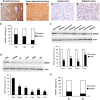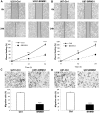BRMS1 suppresses glioma progression by regulating invasion, migration and adhesion of glioma cells
- PMID: 24879377
- PMCID: PMC4039505
- DOI: 10.1371/journal.pone.0098544
BRMS1 suppresses glioma progression by regulating invasion, migration and adhesion of glioma cells
Retraction in
-
Retraction: BRMS1 Suppresses Glioma Progression by Regulating Invasion, Migration and Adhesion of Glioma Cells.PLoS One. 2022 Jun 14;17(6):e0270174. doi: 10.1371/journal.pone.0270174. eCollection 2022. PLoS One. 2022. PMID: 35700162 Free PMC article. No abstract available.
Abstract
Breast cancer metastasis suppressor 1 (BRMS1) is a metastasis suppressor gene in several solid tumors. However, the expression and function of BRMS1 in glioma have not been reported. In this study, we investigated whether BRMS1 play a role in glioma pathogenesis. Using the tissue microarray technology, we found that BRMS1 expression is significantly decreased in glioma compared with tumor adjacent normal brain tissue (P<0.01, χ(2) test) and reduced BRMS1 staining is associated with WHO stages (P<0.05, χ(2) test). We also found that BRMS1 was significantly downregulated in glioma cell lines compared to normal human astrocytes (P<0.01, χ(2) test). Furthermore, we demonstrated that BRMS1 overexpression inhibited glioma cell invasion by suppressing uPA, NF-κB, MMP-2 expression and MMP-2 enzyme activity. Moreover, our data showed that overexpression of BRMS1 inhibited glioma cell migration and adhesion capacity compared with the control group through the Src-FAK pathway. Taken together, this study suggested that BRMS1 has a role in glioma development and progression by regulating invasion, migration and adhesion activities of cancer cells.
Conflict of interest statement
Figures




Similar articles
-
Breast cancer metastasis suppressor 1 inhibits gene expression by targeting nuclear factor-kappaB activity.Cancer Res. 2005 May 1;65(9):3586-95. doi: 10.1158/0008-5472.CAN-04-3139. Cancer Res. 2005. PMID: 15867352
-
Fascin is a key regulator of breast cancer invasion that acts via the modification of metastasis-associated molecules.PLoS One. 2011;6(11):e27339. doi: 10.1371/journal.pone.0027339. Epub 2011 Nov 4. PLoS One. 2011. PMID: 22076152 Free PMC article.
-
BRMS1 inhibits expression of NF-kappaB subunit p65, uPA and OPN in ovarian cancer cells.Eur J Gynaecol Oncol. 2014;35(3):236-42. Eur J Gynaecol Oncol. 2014. PMID: 24984534
-
Breast carcinoma metastasis suppressor gene 1 (BRMS1): update on its role as the suppressor of cancer metastases.Cancer Metastasis Rev. 2015 Dec;34(4):611-8. doi: 10.1007/s10555-015-9583-z. Cancer Metastasis Rev. 2015. PMID: 26328523 Review.
-
The role of matrix metalloproteinase genes in glioma invasion: co-dependent and interactive proteolysis.J Neurooncol. 2001 Jun;53(2):213-35. doi: 10.1023/a:1012280925031. J Neurooncol. 2001. PMID: 11716072 Review.
Cited by
-
Metastasis Inhibition by Cell Type Specific Expression of BRMS1 Gene under The Regulation of miR200 Family Response Elements.Cell J. 2021 Jul;23(2):225-237. doi: 10.22074/cellj.2021.6988. Epub 2021 May 26. Cell J. 2021. PMID: 34096224 Free PMC article.
-
Perturbation of BRMS1 interactome reveals pathways that impact metastasis.PLoS One. 2021 Nov 17;16(11):e0259128. doi: 10.1371/journal.pone.0259128. eCollection 2021. PLoS One. 2021. PMID: 34788285 Free PMC article.
-
Rap2B promotes cell adhesion, proliferation, migration and invasion of human glioma.J Neurooncol. 2019 Jun;143(2):221-229. doi: 10.1007/s11060-019-03163-6. Epub 2019 Apr 17. J Neurooncol. 2019. PMID: 30997639
-
BRMS1 in Gliomas-An Expression Analysis.Cancers (Basel). 2023 May 25;15(11):2907. doi: 10.3390/cancers15112907. Cancers (Basel). 2023. PMID: 37296870 Free PMC article.
-
PDGFR inhibition mediated intracellular signalling in C6 glioma growth and migration: role of ERK and ROCK pathway.Cytotechnology. 2018 Feb;70(1):465-477. doi: 10.1007/s10616-017-0163-7. Epub 2017 Nov 15. Cytotechnology. 2018. PMID: 29143227 Free PMC article.
References
-
- Radner H, Blumcke I, Reifenberger G, Wiestler OD (2002) [The new WHO classification of tumors of the nervous system 2000. Pathology and genetics]. Pathologe 23: 260–283. - PubMed
-
- Wang Q, Qian J, Wang J, Luo C, Chen J, et al. (2013) Knockdown of RLIP76 expression by RNA interference inhibits invasion, induces cell cycle arrest, and increases chemosensitivity to the anticancer drug temozolomide in glioma cells. J Neurooncol 112: 73–82. - PubMed
-
- Seraj MJ, Samant RS, Verderame MF, Welch DR (2000) Functional evidence for a novel human breast carcinoma metastasis suppressor, BRMS1, encoded at chromosome 11q13. Cancer Res 60: 2764–2769. - PubMed
-
- Shevde LA, Samant RS, Goldberg SF, Sikaneta T, Alessandrini A, et al. (2002) Suppression of human melanoma metastasis by the metastasis suppressor gene, BRMS1. Exp Cell Res 273: 229–239. - PubMed
Publication types
MeSH terms
Substances
LinkOut - more resources
Full Text Sources
Other Literature Sources
Miscellaneous

